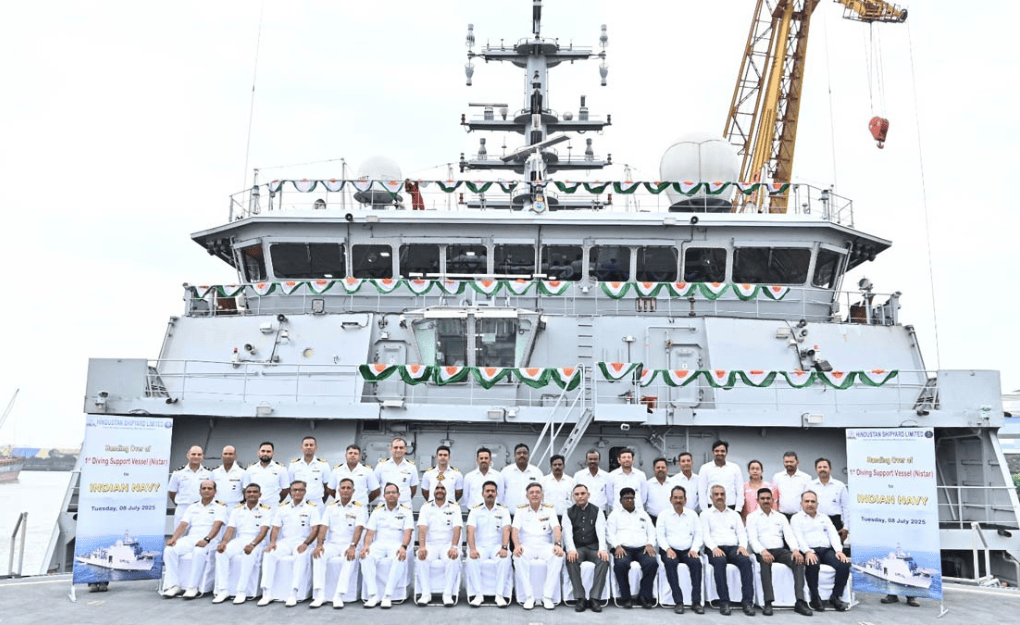The Indigenous DSV Nistar was officially commissioned by the Indian Navy on 18 July 2025 at the Naval Dockyard in Visakhapatnam, marking a significant achievement in India’s journey toward self-reliance in defence production. With Defence Minister Rajnath Singh presiding over the ceremony, the event celebrated India’s technological advancements and operational readiness in the deep-sea rescue domain.
Indigenous DSV Nistar: Design and Construction Excellence
The Diving Support Vessel (DSV) Nistar was designed and constructed by Hindustan Shipyard Limited (HSL), Visakhapatnam, under the ‘Make in India’ initiative. It represents a hallmark of indigenous shipbuilding capabilities, with over 80% of its components sourced locally and more than 120 MSMEs contributing to its construction. The vessel measures approximately 120 metres in length, has a displacement of over 10,000 tonnes, and is equipped with a Dynamic Positioning System, which enables the ship to hold its position precisely during critical underwater operations.
Operational Capabilities: Built for Submarine Rescue and More
The Indigenous DSV Nistar is a multi-role vessel primarily intended for deep-sea diving and submarine rescue missions. Equipped with sophisticated systems such as:
- Air and Saturation Diving Systems
- Remotely Operated Vehicles (ROVs)
- Side Scan SONAR
- Dynamic Positioning Technology
These systems allow it to locate, access, and rescue distressed submarines at depths beyond traditional limits. As a ‘Mother Ship’ to the Deep Submergence Rescue Vehicle (DSRV), Nistar significantly improves India’s underwater rescue capabilities.
Advanced Medical and Support Infrastructure
Nistar is more than a technical vessel; it’s a floating medical facility designed for high-risk rescue missions. Onboard features include:
- Fully equipped Operation Theatre
- Intensive Care Unit (ICU)
- Eight-bedded hospital
- Hyperbaric treatment facilities for divers suffering from decompression sickness
The vessel can sustain operations at sea for over 60 days, houses a 15-tonne subsea crane, and supports helicopter operations, enabling rapid deployment and aerial coordination during emergencies.
Strategic and Symbolic Importance
Nistar, meaning ‘rescue’ in Sanskrit, is not just a name but a commitment to safety and precision in the maritime domain. The crest, featuring an anchor and dolphin, symbolises reliability and friendship of the sea, respectively. The vessel is now part of the Eastern Naval Command, reinforcing India’s strategic capabilities in the Indian Ocean Region (IOR).
With increasing submarine activity by foreign powers in the IOR, the addition of a DSV like Nistar sends a strong signal about India’s readiness and technological maturity. It also supports Search and Rescue (SAR) operations, underwater salvage, and patrolling missions in high seas—vital components of maritime security in peacetime and conflict scenarios.
Legacy of the Name: Nistar Through the Years
This vessel inherits the name and mission of the earlier INS Nistar, a Soviet-built submarine rescue ship inducted in 1969 and decommissioned in 1989. The new Nistar’s motto—‘Surakshita Yatharthta Shauryam’, meaning ‘Deliverance with Precision and Bravery’—embodies the Indian Navy’s ethos in executing high-risk underwater operations.
Nistar is the first of a two-ship class, with her sister ship ‘Nipun’ under construction. This pair will serve as the backbone of India’s indigenous underwater rescue infrastructure.
Enhancing India’s Maritime Self-Reliance
The commissioning of the Indigenous DSV Nistar demonstrates India’s determination to build a self-reliant blue-water navy. By reducing dependence on foreign technology for critical missions such as submarine rescue, the Navy enhances both operational readiness and national security.
India’s move towards indigenous defence production is not only economically prudent but also strategically vital in an era of complex maritime threats. With Nistar in its fleet, India strengthens its ability to respond to underwater emergencies, participate in international submarine rescue collaborations, and project humanitarian and disaster relief operations across the Indo-Pacific.
Conclusion
The Indigenous DSV Nistar is a proud achievement in Indian naval history—merging technological innovation, medical capability, and strategic foresight. As India continues to modernise its naval fleet, vessels like Nistar will play a key role in ensuring operational dominance beneath the waves, while also reinforcing the nation’s commitment to self-reliance and maritime diplomacy in the global arena.




